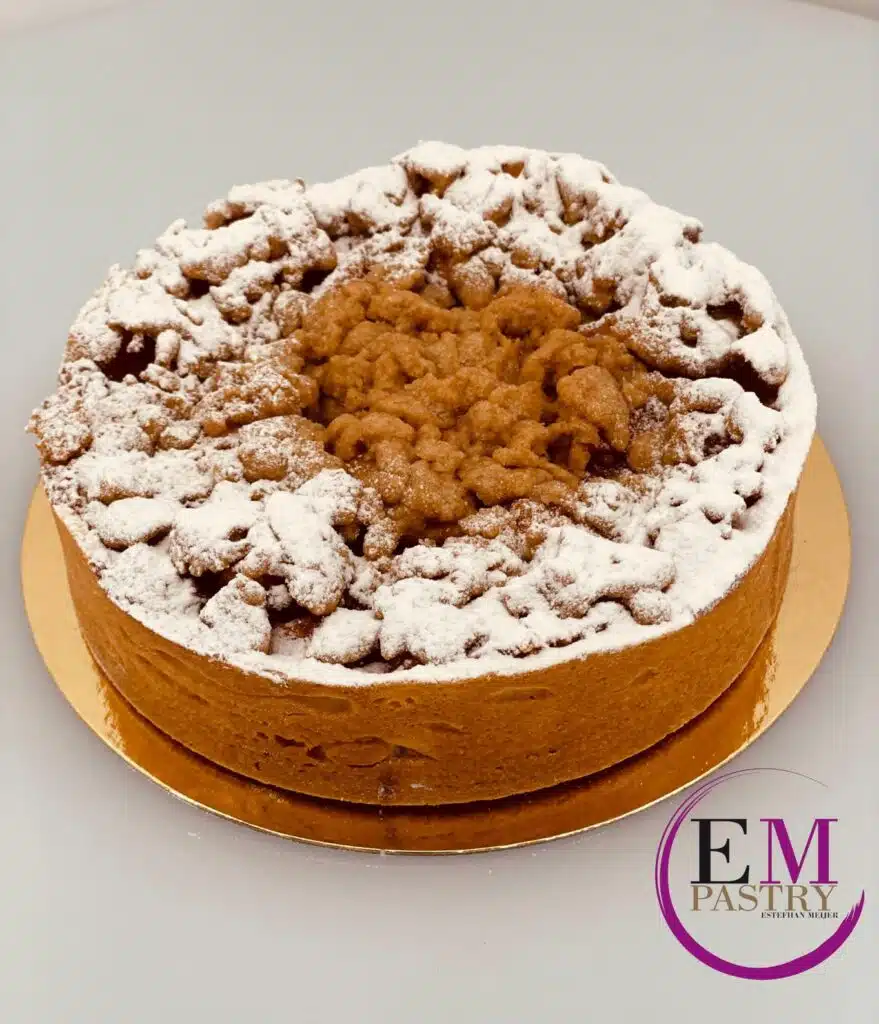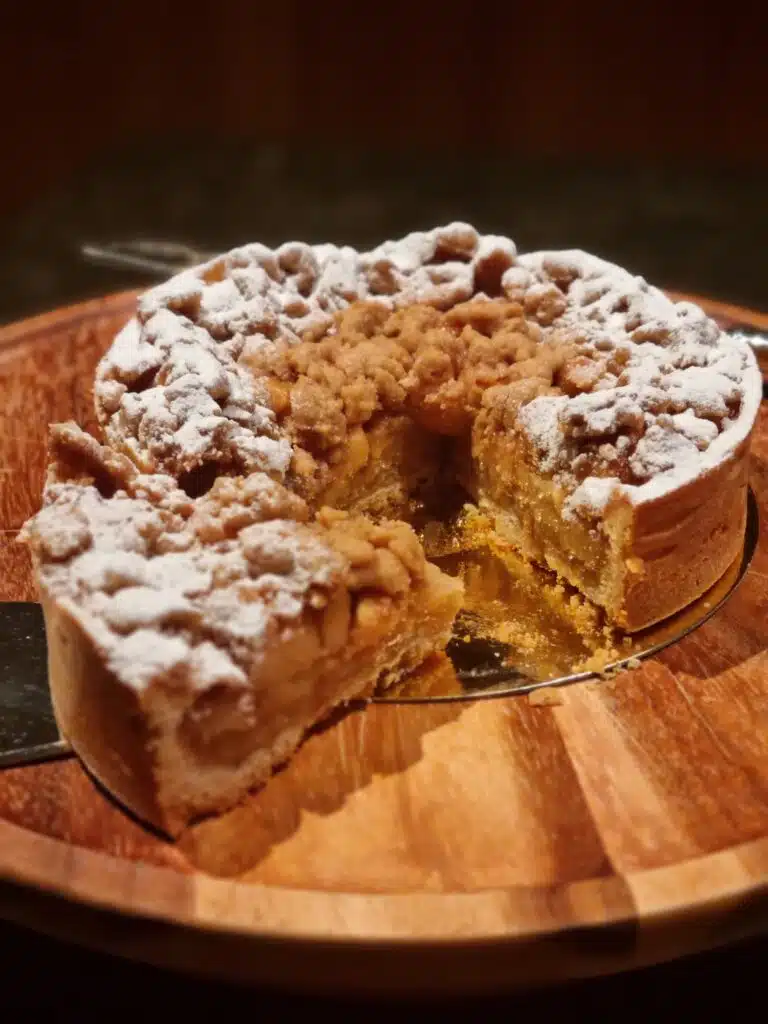Apple pie is a true Dutch pastry, and despite the popular saying, “As American as an apple pie”, the recipe for apple pie can be found in the oldest known Dutch cookbook, dating back to 1514.
You can also eat a “Dutch apple pie” in many American states, but this is often an apple crumble and has less to do with the original Dutch apple pie recipe as a thick crust covering the pie completely is an important trademark for a Dutch apple pie. Maybe the crumble originates from the UK or Germany and has been mixed up with the Dutch version. Incidentally, ‘Dutch’ in the United States often refers to ‘Deutsch’ or German, which also may explain the difference.
On most of our food tours, like the Grand Dutch Food & History Tour, we start with one of Amsterdam’s most famous and delicious homemade apple pies at our beloved Dutch (brown) cafe Papeneiland.
Here, the Tiel family has been baking Dutch apple pie for over 60 years, using Grandma Tiel’s recipe. These days, it is a guy called Han who does most of the baking. If you see a big guy covered in flour emerging from the pub’s cellar, you’ll recognize him and you’ll know fresh apple pies are nearly ready!

At this point, it’s good to mention that we don’t start the food tour with dessert, because for the Dutch, apple pie is not necessarily a dessert. It is a delicacy that we prefer to serve at coffee time or in the early afternoon. Going to a brown cafe for coffee and apple pie after a brisk walk or bike ride, or during a shopping trip, is what the Dutch call “lekker en gezellig” (nice and cozy).
And once you’ve tried the local apple pie, there’s a good chance you’ll want to make your own at home. That’s why we’re sharing one of our favorite recipes with you.
This recipe comes from Estefhan Meijer, a very talented and local pastry chef with many years of experience, including working as head pastry chef for Amsterdam-based and Michelin-starred restaurants such as ‘Bridges’ and ‘Rijks’,. He now runs his own company specializing in creating custom desserts for high end restaurants and catering companies.
For some years, he ran a high- patisserie shop in the Jordaan area and became a valued food partner for Amsterdam Food Tours and good friends with founder Thijs and many of the guides.
Especially for Amsterdam Food Tours, Estefhan has created an apple pie recipe that resembles the rustic Dutch apple pie, but has the upscale taste and look befitting his fabulous patisserie. Indeed, he makes both the famous Dutch crust as well as the crumble in the same pie so he is not helping us out on solving that mystery…
And don’t worry, the recipe is written in such a way that any home cook can make it.
If you do make this apple pie yourself, be sure to send us photos and let us know how it tastes!

Rustic Dutch Apple Pie Recipe
Recipe by Estefhan Meijer, founder of E.M. Pastry. www.empastry.com

Quantities are indicated in grams.
This recipe is intended for two round pies of 16cm in diameter and 4cm high.
Leftover dough can be stored – properly wrapped – for 4 days in the refrigerator or 3 months in the freezer.
There are two reasons for the choice of apple varieties in this recipe. First, these apples release little to no moisture during cooking so the apple pie does not become mushy but remains somewhat firm. Second, they differ in taste; the Elstar is somewhat sweeter and the Goudreinet more sour. This gives a nice contrast in taste and thus a good balance between sweet and sour.
Shortcrust pastry – ingredients
- 180g butter at room temperature
- 80g powdered sugar, sifted
- 80g dry-ground*
- 3g fine sea salt
- 75g beaten egg at room temperature
- 340g all-purpose flour, sifted
*Dry-ground
- 40g powdered sugar, sifted
- 40g almond powder
Place both ingredients in a food processor and pulse until very fine.
Shortcrust pastry – preparation
Combine the butter, powdered sugar, dry-ground, and salt until the butter is lump-free and everything is well blended, but do not over-mix the butter. This can be done on the countertop by hand or with an electric mixer with a flat attachment (also called the butterfly attachment).
Then gradually add the egg and mix until fully combined.
Finally, add the flour and mix to a homogeneous dough; do not knead but mix gently. This will prevent the formation of gluten and ensure that the dough shrinks less during baking. Press the dough into a rectangular shape and wrap it in plastic wrap. Let the dough rest in the refrigerator for at least 20 minutes.
Allowing the dough to rest has two purposes. First, any resulting gluten must relax to prevent shrinkage during baking. Second, the butter needs to stiffen slightly so that the dough can be rolled out later without tearing or sticking to the work surface.
Apple filling – ingredients
- 23g lemon juice
- 8g fresh ginger, peeled and grated
- 370g Elstar apple, peeled and chopped into chunks
- 370g Goudreinet apple, peeled and chopped into chunks
- 110g granulated (caster) sugar
- 3g ground cinnamon
Apple filling – preparation
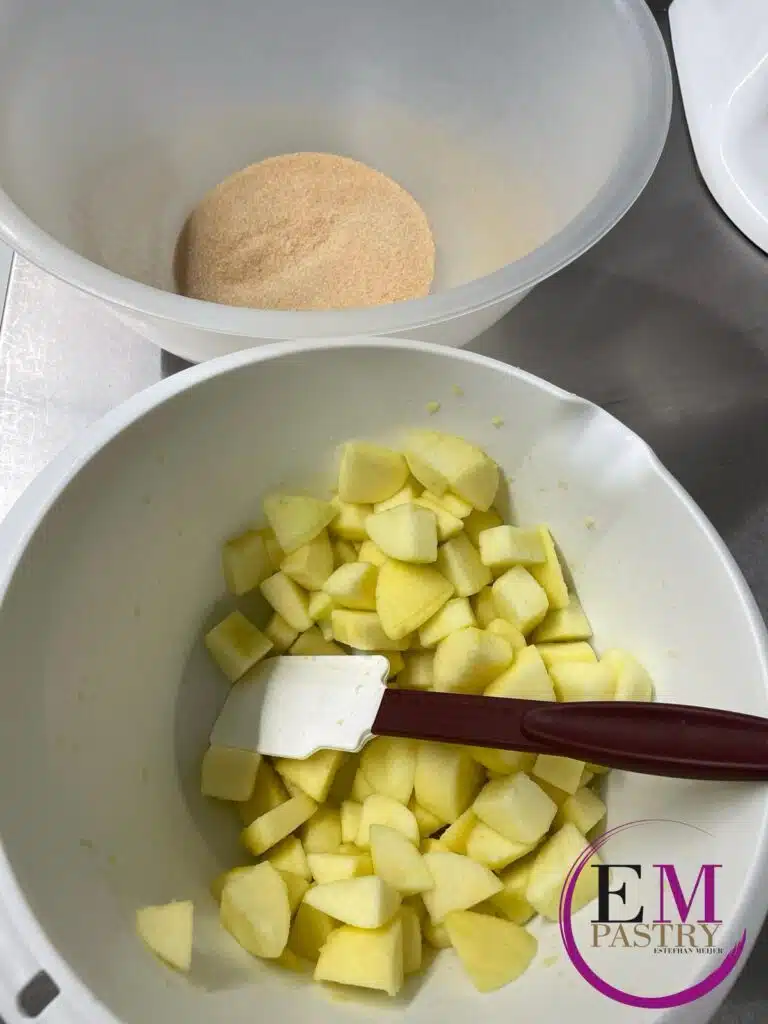
Mix the lemon juice and ginger together, then combine with the apple. This will prevent the apple from oxidizing and of course adds flavor.
Mix the sugar and cinnamon together and add to the apple mixture.
Ground cinnamon is highly hygroscopic. Mixing it with the sugar beforehand will allow it to mix more evenly with the apple and prevent lumps of cinnamon in your filling.

Cinnamon crumble – ingredients
- 90g all-purpose flour, sifted
- 85g granulated (caster) sugar
- 85g melted butter
- 3g ground cinnamon
- 1g fine sea salt
Cinnamon crumble – preparation
Thoroughly mix the dry ingredients together in a bowl, using a baking spatula. Or mix in an electric mixer with butterfly attachment.
Measure the temperature of the butter. It should be 30 degrees Celsius. Then gradually add the melted butter and keep mixing until all the butter is incorporated, and a crumbly dough is formed. Do not knead or press together.
This dough is usable immediately and does not need to rest.
The temperature of the butter is important for the following reasons: If the butter is too cold, it will solidify immediately when added and will not mix completely with the other ingredients. If it is too hot, it will partially flow out of the dough during baking. Therefore, maintain a margin of 29-31 degrees, but preferably aim for 30 degrees.
Construction of the pie
Shortcrust pastry
Place two 16x4cm cake rings on a baking sheet lined with baking paper or silicone baking mat. (If using a springform pan, the baking paper or baking mat is no longer necessary).
Lightly dust a flat, clean surface (preferably marble) with flour.
Weigh out 300g shortcrust pastry per pie and place on the flour. Lightly dust the top of the dough with flour as well. Roll out the dough evenly to a thickness of 4-5mm.
The easiest way to do this is between two slats. Place a 4-5mm thick slat on each side of the dough. Roll out the dough with the rolling pin resting on the slats. This will ensure an evenly rolled dough. Occasionally go under the dough with a palette knife during rolling to prevent the dough from sticking to the surface. Turn the dough a quarter turn each time. Dust with extra flour if necessary, but don’t overdo it – the less the better.
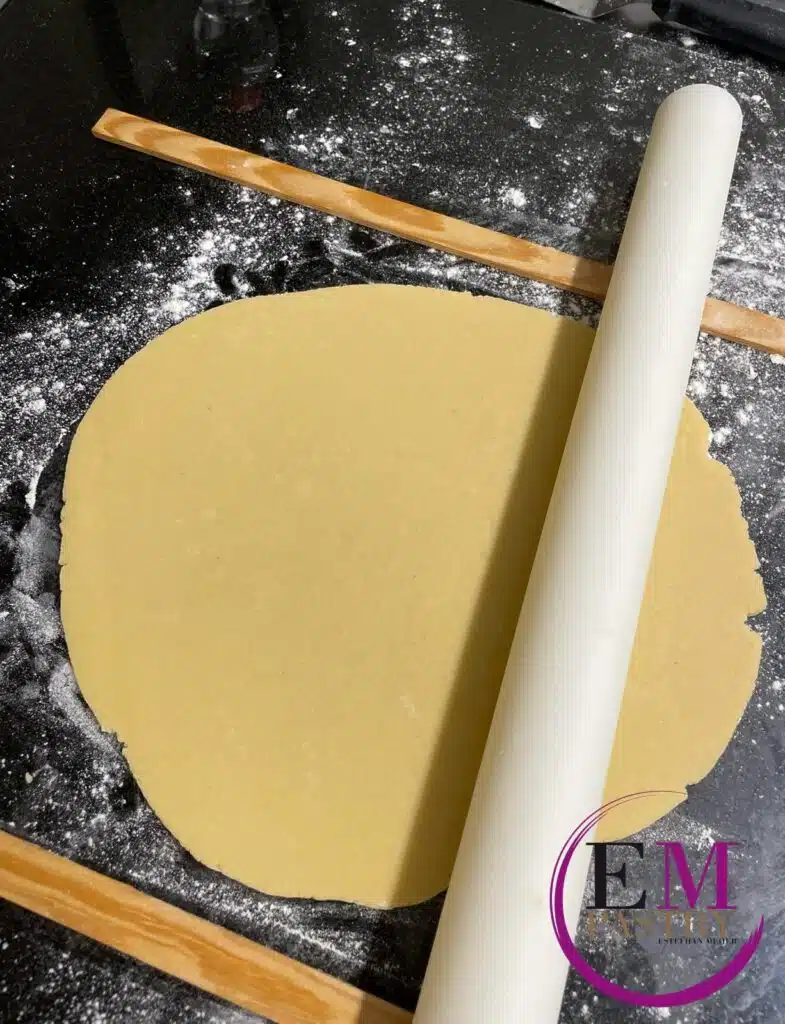
Roll the dough around the rolling pin and gently wipe off excess flour.
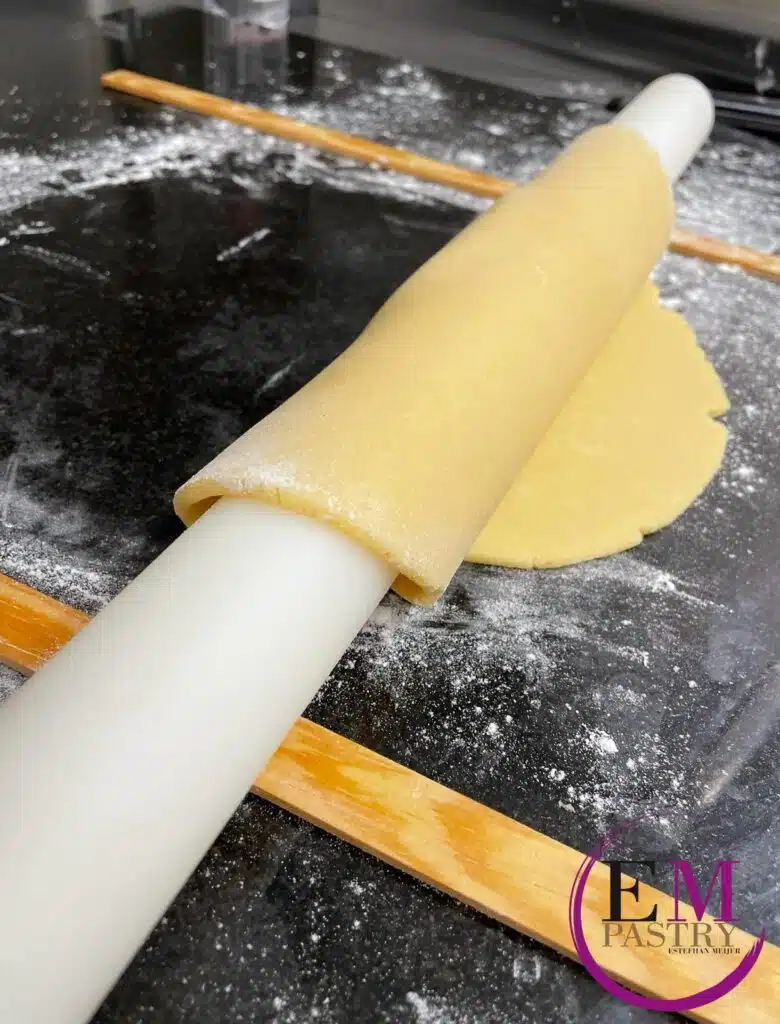
Hold the rolling pin in front of the cake ring and roll the dough from the rolling pin over the cake ring. Gently lift the edges of the dough and place the dough in a controlled manner, as tightly as possible over the bottom and against the wall of the ring. Do not press into the dough. Then roll the rolling pin over the top of the ring to cut the dough perfectly.
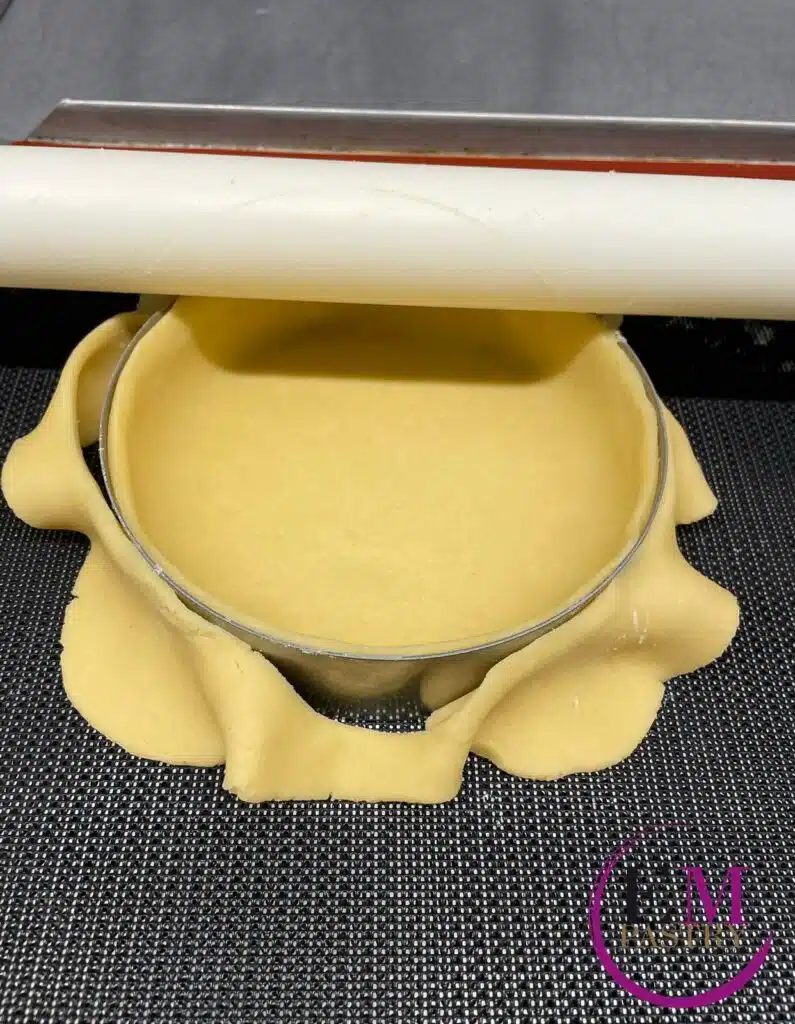
Almond paste
110g almond paste 50%*
Crumble 55g of almond paste per pie evenly over the bottom. Note! Sprinkle it over the bottom. Do not press it or you will damage the dough.
*Almond paste 50% means 50% almond and 50% sugar.

Apple filling
Divide the apple filling between the two pies. Do not press down, otherwise you may damage the dough.
Cinnamon crumble
Loosely sprinkle 75g of cinnamon crumble over the top of each pie.
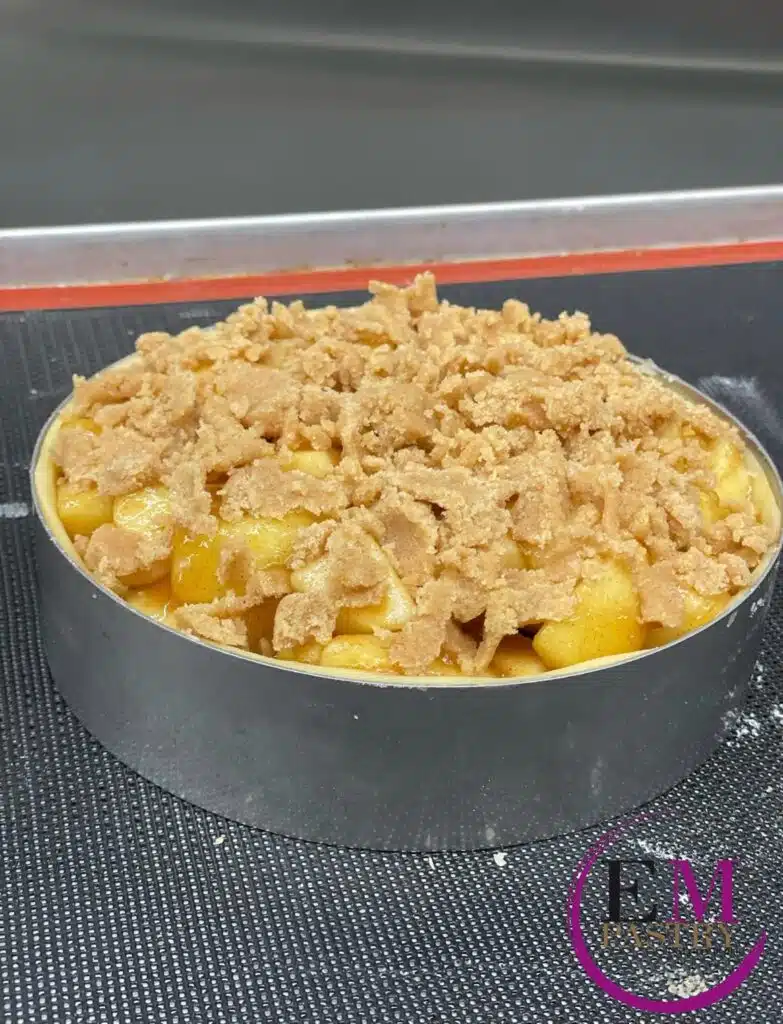
Baking
Preheat the oven to 170 degrees Celsius.
Bake the pies for approximately 1 hour, until golden brown.
Baking times may vary per oven. But count on a minimum of 1 hour, with at most 10 minutes of extra baking time.
Remove the pies from the oven and allow them to cool down on the baking tray(s). Remove the cake rings once these are cool enough to touch.
Optionally: Once the pies have cooled down completely, sprinkle them with powdered sugar.
